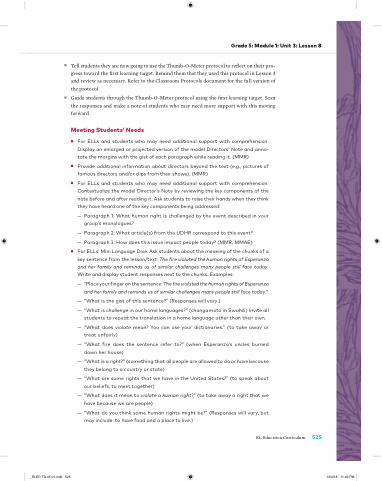Page 549 - EL Grade 5 Teacher Guide
P. 549
Grade 5: Module 1: Unit 3: Lesson 8
■
■
Tell students they are now going to use the Thumb-O-Meter protocol to re ect on their pro- gress toward the rst learning target. Remind them that they used this protocol in Lesson 3 and review as necessary. Refer to the Classroom Protocols document for the full version of the protocol.
Guide students through the Thumb-O-Meter protocol using the rst learning target. Scan the responses and make a note of students who may need more support with this moving forward.
Meeting Students’ Needs
■
■
■
■
For ELLs and udents who may need additional support with comprehension: Display an enlarged or projected version of the model Directors’ Note and anno- tate the margins with the gi of each paragraph while reading it. (MMR)
Provide additional information about directors beyond the text (e.g., pictures of famous directors and/or clips from their shows). (MMR)
For ELLs and udents who may need additional support with comprehension: Contextualize the model Director’s Note by reviewing the key components of the note before and after reading it. Ask udents to raise their hands when they think they have heard one of the key components being addressed:
— Paragraph 1: What human right is challenged by the event described in your group’s monologues?
— Paragraph 2: What article(s) from the UDHR correspond to this event?
— Paragraph 3: How does this issue impact people today? (MMR, MMAE)
For ELLs: Mini Language Dive. Ask udents about the meaning of the chunks of a key sentence from the lesson/text: The re violated the human rights of Esperanza and her family and reminds us of similar challenges many people ill face today. Write and display udent responses next to the chunks. Examples:
—
— —
— — — — — —
“Placeyour ngeronthesentence:The reviolatedthehumanrightsofEsperanza and her family and reminds us of similar challenges many people ill face today.”
“What is the gi of this sentence?” (Responses will vary.)
“What is challenge in our home languages?” (changamoto in Swahili) Invite all udents to repeat the translation in a home language other than their own.
“What does violate mean? You can use your dictionaries.” (to take away or treat unfairly)
“What re does the sentence refer to?” (when Esperanza’s uncles burned down her house)
“What is a right?” (something that all people are allowed to do or have because they belong to a country or ate)
“What are some rights that we have in the United States?” (to speak about our beliefs; to meet together)
“What does it mean to violate a human right?” (to take away a right that we have because we are people)
“What do you think some human rights might be?” (Responses will vary, but may include: to have food and a place to live.)
EL Education Curriculum 525
_ELED.TG.05.01.indb 525
12/4/18 11:49 PM


